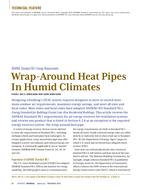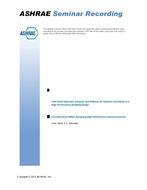Click here to purchase
Ventilation represents large portion of building cooling and heating loads whether it is from the introduction of outdoor air and the need to condition this air or from electric consumption from large central fans that need to move this air through the building regardless if HVAC system is running. In this paper we describe design and development of autonomously operated local ventilation and energy recovery (LVER) unit that can replace or augment traditional inefficient centralized ventilation designs with a distributed network of efficient localized dedicated outside air systems (DOAS), integrated with windows. These systems provide partially conditioned outside air on demand directly to the area where fresh air is required. The window frame integrated LVER unit consists of an energy recovery core and low-power wireless sensors controlled by a low cost computer that minimizes energy use and ensures proper air distribution to perimeter zones. LVER units can be distributed along building façades and mesh-networked with the overall HVAC control systems, including carbon dioxide sensors located in the conditioned perimeter spaces. An energy recovery core is incorporated to condition incoming air for both temperature and moisture content, saving energy due to decreased temperature and humidity differentials between the supply and exhaust air. The The high-performance window and LVER ventilation unit will reduce electricity use by reducing HVAC loads, reducing the size of HVAC equipment and distribution systems, and eliminating the need for perimeter heating and cooling.
Citation: Thermal Buildings XIV 2019
Product Details
- Published:
- 2019
- Number of Pages:
- 10
- Units of Measure:
- Dual
- File Size:
- 1 file , 2.4 MB
- Product Code(s):
- D-Bldgs19-081


